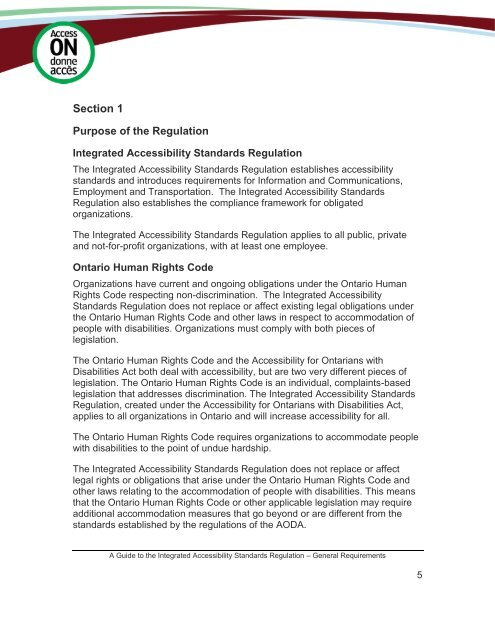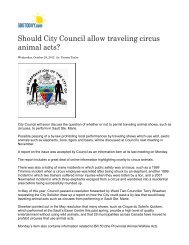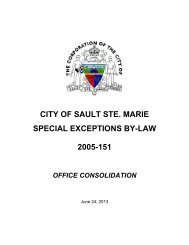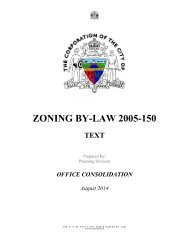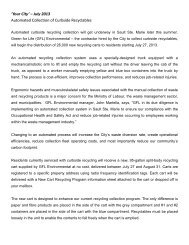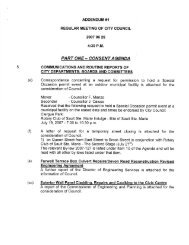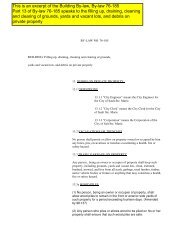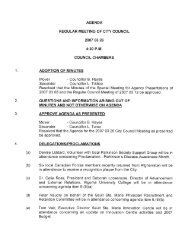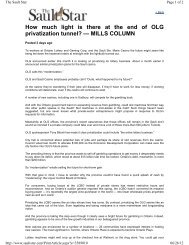- Page 1 and 2: A Guide to the Integrated Accessibi
- Page 3 and 4: Intent of this Requirement ........
- Page 5 and 6: Accessible Formats and Communicatio
- Page 7 and 8: Scope and Interpretation ..........
- Page 9 and 10: Intent of this Requirement ........
- Page 11 and 12: Section 39 ........................
- Page 13 and 14: Section 47 ........................
- Page 15 and 16: Section 55 ........................
- Page 17 and 18: Section 62 ........................
- Page 19 and 20: Intent of this Requirement ........
- Page 21 and 22: Intent of this Requirement ........
- Page 23 and 24: Ontario businesses need to market t
- Page 25: Part 1 - General Requirements Overv
- Page 29 and 30: Section 3 Establishment of Accessib
- Page 31 and 32: Organizations must establish access
- Page 33 and 34: All obligated organizations must de
- Page 35 and 36: Table 2 - When do Organizations hav
- Page 37 and 38: Reviewing and Updating the Accessib
- Page 39 and 40: Section 5 Procuring or Acquiring Go
- Page 41 and 42: Section 6 Self-Service Kiosks Requi
- Page 43 and 44: purchase of a kiosk, organizations
- Page 45 and 46: Table 5 - When do Organizations hav
- Page 47 and 48: Timing of Training In addition to m
- Page 49 and 50: filing accessibility reports. These
- Page 51 and 52: Administrative 9. Definitions and e
- Page 53 and 54: an explanation as to why the inform
- Page 55 and 56: Section 11 Feedback Requirement as
- Page 57 and 58: may choose to meet and talk with th
- Page 59 and 60: Section 12 Accessible Formats and C
- Page 61 and 62: text transcripts of visual and audi
- Page 63 and 64: variety of reasons, such as the ava
- Page 65 and 66: Table 8 - When do Organizations hav
- Page 67 and 68: For example, the Fire Code requires
- Page 69 and 70: 1. By January 1, 2014, new internet
- Page 71 and 72: Table 9 - When do Organizations hav
- Page 73 and 74: Organizations should refer to the d
- Page 75 and 76: complex diagrams accessible to peop
- Page 77 and 78:
named by the Minister of Education
- Page 79 and 80:
In many cases, the resources and ma
- Page 81 and 82:
Section 16 Training to Educators Re
- Page 83 and 84:
esources or materials. Examples:
- Page 85 and 86:
learning resources to educational a
- Page 87 and 88:
Implementing the Requirement When r
- Page 89 and 90:
Section 19 Public Libraries Require
- Page 91 and 92:
materials that are available in acc
- Page 93 and 94:
Recruitment, assessment and selecti
- Page 95 and 96:
Section 21 Schedule Requirement as
- Page 97 and 98:
Section 22 Recruitment General Requ
- Page 99 and 100:
Section 23 Recruitment, Assessment
- Page 101 and 102:
Section 24 Notice to Successful App
- Page 103 and 104:
Section 25 Informing Employees of S
- Page 105 and 106:
Section 26 Accessible Formats and C
- Page 107 and 108:
fact sheets on health and safety in
- Page 109 and 110:
Government of Ontario and Legislati
- Page 111 and 112:
When an Employee Needs Assistance E
- Page 113 and 114:
Section 28 Documented Individual Ac
- Page 115 and 116:
Small private and not-for-profit em
- Page 117 and 118:
Section 29 Return to Work Process R
- Page 119 and 120:
has a disease that results in an ev
- Page 121 and 122:
Implementing the Requirement Employ
- Page 123 and 124:
Affected Organizations Compliance D
- Page 125 and 126:
Implementing the Requirement Employ
- Page 127 and 128:
Sections 41- 43 — Accessibility P
- Page 129 and 130:
designated public sector transporta
- Page 131 and 132:
Integrated Accessibility Standards
- Page 133 and 134:
Section 34 Availability of Informat
- Page 135 and 136:
Section 35 Non-Functioning Accessib
- Page 137 and 138:
When do Organizations have to Compl
- Page 139 and 140:
Section 37 Emergency Preparedness a
- Page 141 and 142:
Section 38 Fares, Support Persons R
- Page 143 and 144:
Section 39 Transition — Existing
- Page 145 and 146:
A vehicle is considered to be in th
- Page 147 and 148:
Section 41 Accessibility Plans —
- Page 149 and 150:
Other Accessibility Plan Requiremen
- Page 151 and 152:
Within the multi-year accessibility
- Page 153 and 154:
For more information on accessibili
- Page 155 and 156:
Implementing the Requirement Conven
- Page 157 and 158:
Section 45 Alternative Accessible M
- Page 159 and 160:
Section 46 Fares Requirement as Sta
- Page 161 and 162:
Section 47 Transit Stops Requiremen
- Page 163 and 164:
These vehicles, unlike subways, are
- Page 165 and 166:
(6) Subject to subsection (7), conv
- Page 167 and 168:
Section 49 Courtesy Seating Require
- Page 169 and 170:
The style or symbol used to mark th
- Page 171 and 172:
The providers will also make sure t
- Page 173 and 174:
Section 51 Pre-Boarding Announcemen
- Page 175 and 176:
All electronic announcements must m
- Page 177 and 178:
Intent of this Requirement The inte
- Page 179 and 180:
Sections 53 - 62 Conventional Trans
- Page 181 and 182:
Section 53 Grab Bars, Handholds, Ha
- Page 183 and 184:
eferenced in subsection (4) on or a
- Page 185 and 186:
They must be designed to prevent ca
- Page 187 and 188:
Intent of this Requirement The inte
- Page 189 and 190:
Section 55 Allocated Mobility Aid S
- Page 191 and 192:
Affected Organizations Compliance D
- Page 193 and 194:
Section 56 Stop Requests and Emerge
- Page 195 and 196:
Affected Organizations Compliance D
- Page 197 and 198:
Section 57 Lighting Features Requir
- Page 199 and 200:
Implementing the Requirement The ge
- Page 201 and 202:
Section 58 Signage Requirement as S
- Page 203 and 204:
Affected Organizations Compliance D
- Page 205 and 206:
The text must be high colour-contra
- Page 207 and 208:
(4) Despite subsection (1), where a
- Page 209 and 210:
Vehicles regulated under Ontario Re
- Page 211 and 212:
(4) Conventional transportation ser
- Page 213 and 214:
A minimal glare surface is one that
- Page 215 and 216:
(7) Despite subsection (6), where a
- Page 217 and 218:
The visual warning lamp indicator a
- Page 219 and 220:
Table 41 - When do Organizations ha
- Page 221 and 222:
Section 63 Categories of Eligibilit
- Page 223 and 224:
Example: During the spring, summer
- Page 225 and 226:
(9) In this section, ―personal in
- Page 227 and 228:
The applicants have temporary eligi
- Page 229 and 230:
Under this requirement, the special
- Page 231 and 232:
Section 66 Fare Parity Requirement
- Page 233 and 234:
Transportation service providers th
- Page 235 and 236:
Section 67 Visitors Requirement as
- Page 237 and 238:
Section 68 Origin to Destination Se
- Page 239 and 240:
Section 69 Coordinated Service Requ
- Page 241 and 242:
Section 70 Hours of Service Require
- Page 243 and 244:
Same Transportation Service Provide
- Page 245 and 246:
Example: A person with a disability
- Page 247 and 248:
No Unreasonable Policies or Practic
- Page 249 and 250:
This is intended to assist people w
- Page 251 and 252:
Section 74 Companions and Children
- Page 253 and 254:
Section 75 School Transportation Re
- Page 255 and 256:
These requirements apply to school
- Page 257 and 258:
Note: The individual school transpo
- Page 259 and 260:
Section 76 Public Sector Organizati
- Page 261 and 262:
Note: Transportation services offer
- Page 263 and 264:
―Code of Practice‖ and ―Code
- Page 265 and 266:
Requirements and dates related to t
- Page 267 and 268:
design criteria to be considered in
- Page 269 and 270:
In general, an accessible taxicab i
- Page 271 and 272:
Table 47 - When do Organizations ha
- Page 273 and 274:
Appendix A Glossary Purpose This gl
- Page 275 and 276:
designated public sector organizati
- Page 277 and 278:
internet website -- an organization
- Page 279 and 280:
self-service kiosk -- refers to tho
- Page 281:
The first version, WCAG 1.0, was re


